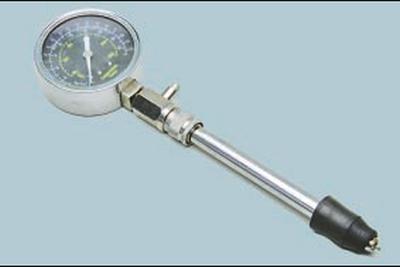
There are options for compression meters similar to those shown in the photo..

...and also those that have a rubber tip instead of a threaded fitting for screwing in instead of a spark plug. Such compression gauges, when checking compression, are simply strongly pressed against the candle hole.
Compression (pressure at the end of the compression stroke) in cylinders - the most important indicator for diagnosing the condition of the engine without disassembling it. By its average value and by the difference in values in individual cylinders, it is possible to determine with sufficient accuracy the degree of general wear of the parts of the cylinder-piston group of the engine, as well as to identify malfunctions of this group and parts of the valve mechanism.
NOTE: Important conditions for the correct readings when checking compression are the serviceability of the starter and its electrical circuits, as well as the full charge of the battery.
NOTE: Before checking the compression in the cylinders, it is necessary to correctly set the valve clearances.
1. Start the engine and warm it up to operating temperature.
2. Remove the decorative engine cover (see Removal and installation of a decorative casing of the engine).
3. Reduce the pressure in the engine power system (see Reducing the pressure in the engine supply system).
NOTE: The engine control module receives an error message when the fuel pump relay or fuse is removed, or when electrical components are disconnected. After performing a compression test, this message should be deleted from the computer's RAM.
4. Remove the ignition coil.
5. Unscrew and remove the spark plugs.
6. Perform the measurement in accordance with the instructions supplied with the compression tester.
NOTE: Use a compression gauge with a suitable adapter.
NOTE: Run the starter at wide open throttle until the needle on the gauge stops moving up.
7. Write down the readings of the compression gauge and set its needle to zero by pressing the air release valve.
NOTE: Other designs of compression gauges may reset the readings in other ways (in accordance with the instructions for the device).
8. Repeat operations for other cylinders. Low compression in individual cylinders can result from loose valves in the seats, damaged cylinder head gaskets, broken or burnt piston rings.
Low compression in all cylinders indicates worn piston rings.
9. Install all parts in the reverse order of removal.
Visitor comments